484
IEEE SYSTEMS JOURNAL, VOL. 2, NO. 4, DECEMBER 2008
System-of-Systems Engineering Management: A
Review of Modern History and a Path Forward
Alex Gorod, Member, IEEE, Brian Sauser, Member, IEEE, and John Boardman
Abstract—As our knowledge of system of systems (SoS) has
grown and evolved, so has our understanding of how to engineer
and manage them. In systems engineering, we develop architec-
tures and frameworks to bring meaning to this kind of uncertainty,
but for SoS engineering (SoSE) we are still in search of how we
can structure this understanding. In this paper, we review the
SoS literature to illustrate the need to create an SoSE manage-
ment framework based on the demands of constant technological
progress in a complex dynamic environment. We conclude from
this review that the history and evolution of defining SoS has
shown that: 1) SoS can be defined by distinguishing characteristics
and 2) SoS can be viewed as a network where the “best practices”
of network management can be applied to SoSE. We use these two
theories as a foundation for our objective to create an effective
SoSE management framework. To accomplish this, we utilize
modified fault, configuration, accounting, performance, and secu-
rity (FCAPS) network principles (SoSE management conceptual
areas). Furthermore, cited distinguishing characteristics of SoS
are also used to present a SoSE management framework. We
conclude with a case analysis of this framework using a known
and well-documented SoS (i.e., Integrated Deepwater System) to
illustrate how to better understand, engineer, and manage within
the domain of SoSE.
Index Terms—Autonomy, belonging, connectivity, diversity,
emergence, fault, configuration, accounting, performance, and
security (FCAPS), system-of-system engineering (SoSE) man-
agement conceptual areas, system-of-systems engineering man-
agement framework, system-of-system engineering management
matrix (SoSEMM).
I. INTRODUCTION
W HILE the research on system of systems (SoS) has
shown significant development in studies and experi-
mental applications on this topic, a review of relevant modern
literature reveals that we are still in an embryonic state in
terms of identifying an effective methodology to achieve the
objectives of system-of-systems engineering (SoSE). We can
trace the origin of the concept of systems, and thus SoS, to
“the Greek word sustema (that) stood for reunion, conjunction
or assembly” [1]. From its origin, we can track the evolution
of this term as it has been studied through general systems
theory, systemics, and cybernetics. Today, IEEE Standard 1220
set or arrangement of elements
defines a System as a: “
Manuscript received April 17, 2008; revised August 25, 2008. First published
November 18, 2008; current version published December 31, 2008.
The authors are with the School of Systems and Enterprises, Stevens Insti-
tute of Technology, Hoboken, NJ 07030 USA (e-mail: agorodis@stevens.edu;
bsauser@stevens.edu; boardman@stevens.edu).
Color versions of one or more of the figures in this paper are available online
at http://ieeexplore.ieee.org.
Digital Object Identifier 10.1109/JSYST.2008.2007163
[people, products (hardware and software) and processes (fa-
cilities, equipment, material, and procedures)] that are related
and whose behavior satisfies customer/operational needs, and
provides for the life cycle sustainment of the products” [2].
Just as the term has evolved, so has our understanding of
how to conceptualize and realize (i.e., engineer) systems. As
the world experienced major structural and operational changes
in production and manufacturing around World War II, there
was a significant paradigm shift in dealing with new complexi-
ties by introducing new engineering techniques that focused on
a complex system rather than separate individual components.
This became known as the discipline of systems engineering
(SE). Still, a process of rapid global acceleration, especially
in the military sector, continued and called for the next level
of development in engineering. The objective was to address
shortcomings in the ability to deal with difficulties gener-
“
ated by increasingly complex and interrelated system of sys-
tems” [3].
There was a need for a discipline that focused on the engi-
neering of multiple integrated complex systems [3]. Today, we
refer to this as SoSE. Unfortunately, we are still attempting to
understand its principles, practices, and execution. There is no
universally accepted definition of SoSE or SoS [4] despite the
fact that there have been multiple attempts to create one. For ex-
ample, Kotov used the definition, “Systems of systems are large
scale concurrent and distributed systems that are comprised of
complex systems” [5]; Manthorpe’s military-specific definition
states, “In relation to joint warfighting, system of systems is con-
cerned with interoperability and synergism of Command, Con-
trol, Computers, Communications, and Information (C4I) and
Intelligence, Surveillance, and Reconnaissance (ISR) Systems”
[6]; and Luskasik’s education-specific definition states, “SoSE
involves the integration of systems of systems that ultimately
contribute to evolution of the social infrastructure” [7].
Alternatively, some researchers have taken a different ap-
proach by focusing on a characterization rather than providing
an abstract definition of SoS [8]–[11]. This characterization
approach provides a more comprehensive and precise tax-
onomy whereas the definitional approach is limited to an
industry-specific context and lacks the flexibility necessary for
successful dynamic trans-disciplinary engineering processes
[12]. In addition, the use of characteristics enables us to better
identify the dynamic nature of various forces within SoS [11].
The goal of SoSE has remained consistent in the literature.
It is comprised of the successful engineering of multiple inte-
grated complex systems. Thus, with a foundation in complex
systems we have also had to embrace the principles of networks.
Shenhar [13] was one of the first to describe SoS as a network
of systems functioning together to achieve a common purpose.
1932-8184/$25.00 © 2008 IEEE
�
GOROD et al.: SoSE MANAGEMENT: A REVIEW OF MODERN HISTORY AND A PATH FORWARD
485
Fig. 1.
Increasing SE knowledge and practice [18].
Later, others including Maier [14] and Lane and Valerdi [15]
identified other universally known network-centric systems as
examples of collaborative SoS (i.e., the internet, global com-
munication networks, etc.). Recently, Gorod, et al. [16], sug-
gested extracting the best practices of network management that
would enable the development of an effective SoSE manage-
ment framework.
In this paper, we will bridge these two perspectives of SoS,
characterization and networks, to build a framework for under-
standing how we can realize and manage SoS. The fundamental
value in a framework is being able to correctly associate the def-
inition and arrangement of a system [17]. We will first provide
a review of the modern literature on SE and SoSE, so we may
understand where we have come and where we can go. Second,
we will present a characterization approach to describe SoS that
has been built on a review of the SoS literature. Third, we will
present our SoSE management framework based on this charac-
terization approach and the principles of network management.
Finally, we will apply this framework to an SoS case study to
exemplify its realization.
II. STATE OF KNOWLEDGE AND PRACTICE
While the body of knowledge for SE has been well docu-
mented by many organizations [e.g., International Council on
Systems Engineering (INCOSE), IEEE, Department of De-
fense], Brill’s [18] work summarizes the major advancements
in the study of SE that took place from 1950 to 1995. We will
refer to Brill’s work in order to establish what we know about
SE. We will then perform a similar exercise as Brill to examine
the literature of significant contributors to the body of knowl-
edge for SoSE. This includes journal publications, conference
proceedings, standards, guides, government documents, and
different relevant events from 1991 to present. We summarize
both bodies of knowledge by comparing the major drives that
separate SE from SoSE.
A. Systems Engineering (SE)
Fig. 1 depicts Brill’s graphical timeline of the key contribu-
tors to highlight milestones in the study of SE and its application
[18].
According to Hall [19], the first major contributor to the de-
velopment of SE was Gilman, who probably made the first at-
tempt to teach SE at the Massachusetts Institute of Technology
in 1950.
The second significant contribution came from Goode and
Machol. They acknowledged the need for a new method of or-
ganization through “the systems design, systems analysis, and
systems approach” [20].
In 1957, Engstrom, explained the concept of SE through the
use of terms such as evolution and characteristics [21].
In 1962, Hall introduced a concept of “process of systems
engineering” that included three important elements. First, to
acquire better knowledge about this complex phenomenon, it
was imperative to recognize that systems had to include multi
facets in its definition. Second, an engineer had to examine a
system from three distinct environmental positions—“the phys-
ical or technical,” “business or economic,” and “social.” Third,
according to the Total Quality Management Principle, to most
effectively fulfill customers’ objectives, all available knowledge
had to be used. This element was further addressed and ex-
plained in Hall’s Metasystems Methodology [19], [22].
In the 1960’s, Shinners and Chestnut, worked to create a
methodology to solve any system-oriented problems through
first understanding them. In 1967, Shinners proposed to use
�
486
IEEE SYSTEMS JOURNAL, VOL. 2, NO. 4, DECEMBER 2008
seven general procedures to generate a feedback process in en-
gineering a large complex system [23]. Chestnut similarly ex-
plored an option of the feedback process to best determine a
manner to meet the customers’ objectives. He suggested several
questions in addressing the ability to formulate and solve the
problem [24].
In 1973, Miles worked on editing ten lectures by well-recog-
nized members of scientific community on the topic of “Systems
Concepts for the Private and Public Sectors” [25]. He articulated
a six step approach to meet specific systems engineering goals.
He suggested that instead of focusing only on the analysis and
design of distinct components, it would be more useful to con-
centrate on the problem “in its entirety” [25].
In 1974, Chase correctly pointed out that the inadequate state
of language development prevented effective communication on
topics related to the systems concepts, and there was a lot of
work that needed to be done to remedy the situation [26].
In 1976, Wymore put “interdisciplinary team using uni-
form and standard systems engineering methodology” as a
core component in addressing the problem of the “design and
analysis of large scale, complex/machine systems” [18], [27].
This methodology primarily focused on the effective com-
munication manner of the interdisciplinary team concept. It
included “modeling human behavior, dealing with complexity
and largeness-of-scale,” and managing dynamic technology
[18], [27].
In 1981, Blanchard and Fabrycky introduced the concept of
“system-life-cycle-engineering” similar to the studies done by
Hall centered on such notions as problem detection and defini-
tion; planning and designing of a system; and implementation
and obsolescence [19]. They emphasized the need for systems
engineers to include all aspects of the system in the proper ap-
plication of the “system-life-cycle” concept [28].
In 1995, Sage was the first author to suggest that “systems
engineering is the management technology that controls a total
lifecycle process, which involves and which results in the defi-
nition, development, and deployment of a system that is of high
quality, trustworthy, and cost effective in meeting user needs”
[29]. Sage introduced the key definitions of the systems engi-
neering concept through structure, function, and purpose [29].
Also, at the same time, there were several noteworthy organi-
zations that provided significant contributions to the studies of
systems engineering. They published handbooks, standards, and
guides related to the advancements in the field.
In 1966,
the United States Air Force (USAF) was the
first organization to publish a handbook describing a sys-
tems engineering process [30]. In 1969, it was replaced with
MIL-STD-499 [31].
In 1974, the new MIL-STD-499A introduced the Systems En-
gineering Management Plan (SEMP) [32]. In 1979, the U.S.
Army published guidelines for implementing and managing a
systems engineering process [33].
In 1983, The Defense Systems Management College intro-
duced the first edition of the Systems Engineering Management
Guide (SEMG) that became popular within the defense industry
as a hands-on tool for systems engineering in the military field
[34]. In 1989, the Electronic Industries Association (EIA) issued
a report to designate systems engineering as “a central process”
in meeting “user operational requirements
ment design” [18].
for system/equip-
In 1990, the first professional organization was established
to study the field of systems engineering. It became known
as the National Council on Systems Engineering (NCOSE).
In 1992, the U.S. Air Force released an updated version of
the first handbook MIL-STD-499A that contained a more
comprehensive approach to systems engineering. It was called
MIL-STD-499B [35]. In 1994, the EIA, with the assistance of
other professional associations, published an Interim Standard
632 that reflected continued efforts to create a defined manage-
ment process for engineering systems [36]. Finally, in 1995,
both IEEE and NASA published their respective reports on sys-
tems engineering. The IEEE’s PI220 and NASA’s SE-HNBK,
similar to EIA’s Interim Standard 632, focused on the creation
of the management process for engineering systems and were
generally consistent with the process described by Goode and
Machol and Shinners [18], [20], and [23].
In the last 50 years we have seen tremendous progress in our
ability to understand, design, develop, implement, and manage
single systems. This is an outcome of the research done in the
field of SE. Researchers and practitioners from many different
disciplines and fields have contributed. As we face a new phe-
nomenon of SoSE the focus has changed. Instead of single sys-
tems we now have to cope with multiple integrated complex sys-
tems [3]. However, the basic principals of SE can be applied to
SoSE. Therefore, it is imperative for us to use SE as a founda-
tion for the research in the field of SoSE.
B. System of Systems Engineering (SoSE)
The initial mention of the SoS can be traced to Boulding
[37], Jackson and Keys [38], Ackoff [39], and Jacob [40].
Boulding imagined SoS as a “gestalt” in theoretical construc-
tion creating a “spectrum of theories” greater than the sum of
its parts. Jackson and Keys suggested using the “SoS method-
ologies” as interrelationship between different systems-based
problem-solving methodologies in the field of operation re-
search. Ackoff considered SoS as a “unified or integrated
set” of systems concepts. Jacob stated that a SoS is “every
object that biology studies.” It was not until 1989, with the
Strategic Defense Initiative, that we find the first use of the term
“system-of-systems” to describe an engineered technology
system [41].
The transition to the accepted modern term SoS is reflected
in Fig. 2 and is introduced in the works of Eisner et al. [42],
[43] and Shenhar [13]. Eisner et al. defined SoS as: “A set of
several independently acquired systems, each under a nominal
systems engineering process; these systems are interdependent
and form in their combined operation a multifunctional solution
to an overall coherent mission. The optimization of each system
does not guarantee the optimization of the overall system of
systems” [42].
Shenhar used the term “array” to describe SoS as: “A large
widespread collection or network of systems functioning to-
gether to achieve a common purpose” [13]. In his more recent
works he now describes an “array” as a “system of systems”
[44].
�
GOROD et al.: SoSE MANAGEMENT: A REVIEW OF MODERN HISTORY AND A PATH FORWARD
487
Fig. 2. Modern history of SoS.
In 1995, Holland proposed to study SoS as an artificial com-
plex adaptive system that persistently changes through self or-
ganization with the assistance of local governing rules to adapt
to increasing complexities [45], [46]. Also, in 1995, Admiral
W.A. Owens was the first one to introduce the concept of SoS
and highlight the importance of its development in the military
[47].
In 1996, Manthorpe, Jr. proposed to link command, control,
computers, communication, and information (C4I) with intelli-
gence, surveillance, and reconnaissance (ISR) to join the SoS in
order to achieve “dominant battlespace awareness” [6].
Also, in 1996, Maier, who is still considered to be one of
the most influential contributors to the study of the SoS field,
proposed for the first time to use the characterization approach
to distinguish “monolithic” systems from SoS. These charac-
teristics include “operational independence of the elements,
managerial independence of the elements, evolutionary devel-
opment, emergent behavior, and geographical distribution” [8].
In 1997, Kotov provided one of the most precise definitions of
the SoS in the application of information technology. Also, he
was one of the first scientists to attempt to model and synthesize
SoS [5].
In 1998, Maier published an updated version of his 1996 “Ar-
chitecting Principles of Systems-of-Systems,” where he offered
a new definition of SoS: “A system-of-systems is an assemblage
of components which individually may be regarded as systems,
and which possesses two additional properties: Operational In-
dependence of the Components (and) Managerial Indepen-
dence of the Components
.” [14].
Also, in 1998, Luskasik attempted to apply SoS approach in
the educational context [7].
In 2000, Pei introduced a new concept of “system-of-systems
integration” (SOSI) which gave the ability “to pursue develop-
ment, integration, interoperability, and optimization of systems”
to reach better results in “future battlefield scenarios” [48].
In 2001, four major contributors published their respective
works to address SoS development. They included Sage and
Cupan; Cook; Carlock and Fenton; and Shenhar. Sage and
Cupan proposed to use principles of “new federalism” to
provide a framework for the SoSE [4]. Cook examined SoS
and described a distinction between “monolithic” systems and
SoS based on “system attributes and acquisition approaches”
[49]. He showed that constituent systems of SoS are acquired
through separate processes [49]. Carlock and Fenton suggested
on joining “traditional systems engineering activities with en-
terprise activities of strategic planning and investment analysis”
[50]. They called this type of engineering “enterprise Systems
of Systems engineering” [50]. Finally, Shenhar continued to
expand the concept of “array” from his previous work published
in 1994 [51].
In 2003, Keating, et al., presented a significant comparative
study of SE and SoSE and provided guidelines for several key
phases such as design, deployment, operation, and transforma-
tion of SoS [3]. Also in 2003, Chen and Clothier [52] published
work addressing the need for a SoSE framework. They sug-
gested advancing SE practices beyond traditional project level
to focus on “organizational context” [52].
Another major contribution came from Bar-Yam and his
study group in 2004. He examined applications of SoS in
different fields and suggested adding characteristics as opposed
to definitions to provide a more comprehensive view of SoS [9].
In 2005, there were numerous papers published on the topic
of SoS, but we believe that the most significant inputs were
produced by Jamshidi; Lane and Valerdi; and DeLaurentis.
Jamshidi applied a definitional approach to SoS by collecting
different definitions from various fields [53]. Lane and Valerdi
�
488
IEEE SYSTEMS JOURNAL, VOL. 2, NO. 4, DECEMBER 2008
used a comparative approach to analyze SoS definitions and
concepts in the “cost models” context [15]. DeLaurentis de-
scribed various traits within the transportation domain of SoS,
and suggested the need to continue the search for a “holistic
framework” and methodology [10].
In 2006, Boardman and Sauser published a paper that outlined
the characterization approach to SoS. They identified patterns
and differences in over 40 SoS definitions. By comparing these
patterns and differences against previously identified patterns
of other systems, they translated them into a comprehensive
overview of five distinguishing characteristics of SoS. The char-
acteristics are: autonomy, belonging, connectivity, diversity, and
emergence [11].
In 2008, the first two books dedicated to SoS were introduced
by Jamshidi [54], [55]. These works covered a wide variety of
SoS topics.
In addition to individual research efforts, many professional
organizations, universities, government agencies, and non-for-
profit organizations contributed to the advancement of under-
standing in studies of SoSE.
In 2001, the Department of Defense (DoD) introduced the
following version of Army Software Blocking Policy (ASBP)
v11.4E. It created a mechanism responsible for ensuring that
“system developments” would be harmonized with the “execu-
tion of the program.” It defined SoS as “a collection of systems
that share/exchange information which interact synergistically”
[56].
Also, in 2001, another department within the DoD, published
a report in which it used “Family of Systems” (FoS) in a military
context to describe SoS as a “set of arrangement of interdepen-
dent systems that can be arranged or interconnected in various
ways to provide different capabilities” [57].
In 2004, another standard came from the DoD as part of De-
fense Acquisition Guidebook, where one of the sections was
dedicated to a provision of guidelines during the acquisition
phase of SoS [58].
In 2005, four major events took place—System of Systems
Engineering Center of Excellence (SoSECE) 1st Conference,
System of Systems Report from Purdue University, the estab-
lishment of National Center for System of Systems Engineering
(NCSoSE) at Old Dominion University, and the United States
Air Force (USAF) Report on SoSE.
In 2006, SoS Navigator was published by Carnegie Mellon
University, and the first IEEE Conference dedicated to SoSE
(IEEE SoSE) was held in Los Angeles, CA. Also, the IEEE Sys-
tems Journal was formed to continue the education of the scien-
tific community about significant developments in the study of
SoSE.
In 2007, the DoD published their System of Systems Engi-
neering Guide: Considerations for Systems Engineering in a
System of Systems Environment [46]. The guide describes the
characteristics of SoS environments and identifies complexities
of SoS systems engineering (SoS SE).
Also, in 2007, DeLaurentis et al., proposed to create an In-
ternational Consortium for System of Systems (ICSOS) to ex-
amine the problems and solution strategies related to SoS and
SoSE [59].
TABLE I
MAJOR DRIVERS OF SE AND SoSE
C. Analysis of Literature Review
Table I presents a summary of the literature review including
relevant works of Keating, et al. [3], Maier [14], DeLaurentis
[10], Bar-Yam, et al. [9], and the research group at SoSECE
[60] on the major aspects of both SE and SoSE. Aside from
major differences, there is a gap in the literature in regards to
the management framework of SoSE.
III. SYSTEM OF SYSTEMS ENGINEERING (SOSE) MANAGEMENT
While the scope of engineering and managing systems has
changed dramatically and become a significant challenge in our
ability to achieve success [61], fundamental to understanding
the context of any system is the necessity to distinguish between
the system type and its strategic intent, as well as its systems en-
gineering and managerial problems [62]. Therefore, no single
approach can solve these emerging problems, and thus no one
strategy is best for all projects [63]. As already discussed, there
can be great differences among systems and among the pro-
cesses of their creation. Accordingly, it is a common practice
for most organizations to use some kind of a project or systems
engineering management classification or categorization frame-
work, either explicitly or implicitly [64]. For example, Ahituv
and Neumann [65]; Blake [66]; Steele [67]; and Wheelwright
and Clark [68] were some of the earliest to propose frameworks
for the distinction among systems and projects. While several
others have suggested additional frameworks in an attempt to
categorize and distinguish between different project types (e.g.,
Bubshait and Selen [69]; Floricel and Miller [70]; Pich et al.,
[71]; Shenhar and Dvir [12]; Turner and Cochrane [72]; Youker
[73]), much of this literature has been focused on a single in-
dustry and often on small projects (Soderlund [74]; Tatikonda
and Rosenthal [75]). Thus, the application of these frameworks
to SoS has limited external validity. Furthermore, while most
organizations use classification or categorization systems [64],
only few of these systems are presently grounded in academic-
oriented empirical research.
�
GOROD et al.: SoSE MANAGEMENT: A REVIEW OF MODERN HISTORY AND A PATH FORWARD
489
While the literature in SoS and SoSE is expanding rapidly, we
still do not have an established body of knowledge. We also lack,
as our literature reviews indicated, a management framework for
guiding us in our understanding of these complex systems. We
will present a SoSE management framework that brings together
a leading approach to describing SoS (i.e. characterization) and
a fundamental trait of SoS (i.e. networks). In the next sections
we will describe our characterization and network management
models individually. We will then bring them together to form
a SoSE Management Framework.
Now we are faced with the need to create con-
nectivity, or in other words achieve interoperability,
amongst the legacy systems and possibly additions
of new systems to SoS
It calls for a dynamic de-
termination of connectivity, with interfaces and links
forming and vanishing as the need arises. Thus the
ability of constituent systems to remain autonomous
proves essential, for only then can they hope to make
real-time connections on behalf of the SoS to enable
it achieve and sustain its capabilities [11].
A. SoS Characteristics
Diversity—Evidence of visible heterogeneity:
We have chosen to use the SoS characterization of Boardman
and Sauser [11], [76] because these characteristics are based on
a review of over 40 definitions of SoS from the literature. A
summary of these characteristics is as follows.
Autonomy—The ability of a system as part of SoS to make
independent choices. This includes managerial and oper-
ational independence while accomplishing the purpose of
SoS:
The reason a system exists is to be free to pursue
its purpose. That freedom always comes with con-
straints, of course. But those constraints cannot be
permitted to overwhelm or violate its nature to per-
form. Were this to be the case, the system of neces-
sity would be abandoned and another found to take
its place. True, any given system may fail to fulfill its
purpose, but not for reasons of autonomy. More likely
it is ineffectiveness, efficiency, or even unethical be-
havior. The same cannot be said of a part that is in-
tegral to a system. That part is chosen—designed or
procured—for a given purpose, just as a system is, but
it is deliberately chosen for the reason of serving the
purpose of the whole system [11].
Belonging—Constituent systems have the right and ability
to choose to belong to SoS. The choice is based on their
own needs, beliefs, or fulfillment:
Part of the persuasion comes from the argument
that the achievement of the SoS purpose is exactly
why the system was brought into being, but con-
straints at the time of its origination required a lesser
target to be set. In other words, the new ‘supra’
purpose enfolds the system’s original purpose. And
what is more, the existence of the SoS will enhance
the value of the system’s purpose, exalt the role of
the system, whose belonging makes achievement of
the supra purpose more likely and more effective.
But that belonging does mean partness for the au-
tonomous system. This autonomous legacy system
now exhibits both partness and wholeness [11].
Connectivity—The ability to stay connected to other con-
stituent systems:
A SoS should, out of necessity, be incredibly di-
verse in its capability as a system compared to the
rather limited functionality of a constituent system,
limited by design. It seems to us that there is a funda-
mental distinction to be made between requirements-
driven design for a conventional system based on its
defined scope, and a capabilities-based SoS that must
exhibit a huge variety of functions, on an as-needed
basis, in order to respond to rampant uncertainty, per-
sistent surprise, and disruptive innovation [11].
Emergence—Formation of new properties as a result of
developmental or evolutionary process:
In a system, emergence is deliberately and inten-
tionally designed in. What’s more, unintended conse-
quences, i.e., unpleasant or painful emergent behavior
is tested out, as far as possible. With an SoS, emergent
behavior dare not be restricted to what can be foreseen
or deliberately designed in, even if this risks greater
unintended consequences, though of course these can
still be tested for. A SoS must be rich in emergence be-
cause it may not be obvious what tactical functionality
is required to achieve broad capability. Instead, a SoS
has emergent capability designed into it by virtue of
the other factors: preservation of constituent systems
autonomy, choosing to belong, enriched connectivity,
and commitment to diversity of SoS manifestations
and behavior. The challenge for the SoS designer is
to know, or learn how, as the SoS progresses through
its series of stable states, to create a climate in which
emergence can flourish, and an agility to quickly de-
tect and destroy unintended behaviors [11].
According to Sauser and Boardman [77], these five distin-
guishing characteristics of SoS are influenced by opposing
forces with different degrees of strength within each of them.
Fig. 3 depicts the various forces’ that interact within these
characteristics. We will later use these opposing forces to better
define our framework.
Likewise, we contend that these characteristics are not inde-
pendent but meaningfully interdependent, as they extend from
one extremity to the other for each (i.e., paradox). To understand
the interdependence of these characteristics is to begin to gain
�
490
IEEE SYSTEMS JOURNAL, VOL. 2, NO. 4, DECEMBER 2008
Fig. 3. Distinguishing characteristics of SoS and their opposing forces [78].
access to how they interlock. For example, together the level of
autonomy may determine the degree of belonging, which will
affect the extent of connectivity and possibly restrict the diver-
sity (of elements) and maybe the emergent properties (of the
system). However, equally a shift in diversity may have an ef-
fect in belonging and hence connectivity leading to a rising of
the autonomy level and consequential effect on emergence. Our
only present recourse is to nominate fluxes in the dynamics of
these characteristics based on the experience of designed sys-
tems, and latterly SoS. Thus, we reserve this discovery for fu-
ture research.
B. Network Management
In our review of the literature, we established that SoS can
be viewed as a network. Shenhar [13]; Maier [14]; Lane and
Valerdi [15]; and DeLaurentis [10] all provided examples of col-
laborative SoS such as the Internet, global communication net-
works, transportation networks, etc., which can be managed as
networks. Therefore, we extracted the management practices of
how networks are governed from already established network
management principles [i.e., fault, configuration, accounting,
performance, and security (FCAPS)].
1) FCAPS Principles: FCAPS principles were created by the
International Organization for Standardization (ISO) to provide
a complete management model for Information Technology (IT)
network systems. It has become known as the standard ISO/IEC
7498 [79]. Bass [80] suggested the application of the ISO stan-
dard to managing net-centric systems. Gorod, et al. built upon
this by proposing to extract “best practices” based on these prin-
ciples of network management and apply them to SoSE manage-
ment [16].
The ISO standard is a reference model used to “
provide a
common basis for the coordinated development of management
standards” [79]. It consists of five principles that define termi-
nology, create structure and describe activities for management
of networks. Below is the ISO description of these five princi-
ples with their definitions and some examples of the function-
ality [79].
Fault Management (FM)—Encompasses fault detection,
isolation and the correction of abnormal operation of
the Open Systems Interconnection Environment (OSIE).
Functionality of FM:
1) maintains and examines error logs;
2) accepts and acts upon error detection notifications;
3) traces and identifies faults;
4) carries out sequences of diagnostic tests;
5) corrects faults.
Configuration Management (CM)—Identifies, exercises
control over, collects data from, and provides data to
open systems for the purpose of preparing for, initializing,
starting, providing for the continuous operation of, and
terminating interconnection services. Functionality of CM
includes:
1) setting the parameters that control the routine opera-
tion of the open system;
2) associating names with managed objects and sets of
managed objects;
3) initializing and closing down managed objects;
�
GOROD et al.: SoSE MANAGEMENT: A REVIEW OF MODERN HISTORY AND A PATH FORWARD
491
4) collecting information on demand about the current
condition of the open system;
5) obtaining announcements of significant changes in the
condition of the open system;
6) changing the configuration of the open system.
Accounting Management (AM)—Enables charges to be es-
tablished for the use of resources in the OSIE, and for costs
to be identified for the use of those resources. Functionality
of AM includes:
1) informing users of costs or resources consumed;
2) enabling accounting limits to be set and tariff schedules
to be associated with the use of resources;
3) enabling costs to be combined where multiple re-
sources are invoked to achieve a given communication
objective.
Performance Management (PM)—Enables the behavior of
resources in the OSIE and the effectiveness of communi-
cation activities to be evaluated. Functionality of PM in-
cludes:
1) gathering statistical data;
2) maintaining and examining logs of system state histo-
ries;
3) determining system performance under natural and ar-
tificial conditions;
4) altering system modes of operation for the purpose of
conducting performance management activities.
Security Management (SM)—Support the application of
security policies. Functionality of SM includes:
1) creation, deletion, and control of security services and
mechanisms;
2) distribution of security relevant information;
3) reporting of security relevant events.
2) Conceptual Areas of SoSE Management: While the
description and definitions above apply to Information Tech-
nology (IT) networks, we have theorized that certain values of
the FCAPS principles can be abstracted in order to apply to the
SoSE domain as depicted in Fig. 4 [16]. The resulting concep-
tual areas serve as a foundation for developing a framework for
SoSE management.
These SoSE Management Conceptual Areas can be described
in the following manner.
and
coordinate
Risk Management—Monitor, identify, assess, analyze, and
mitigate risk encountered in the SoS.
Configuration Management—Direct
through functioning and software management.
Performance Management—Monitor and measure perfor-
mance of SoS for it to be maintained at an appropriate level.
Policy Management—Provide SoS access to authorized
processes and protect SoS from illegal access.
Business Management—Coordinate and allocate SoS as-
sets based on use and utilization information of systems in
the SoS.
3) SoSE Management Matrix (SoSEMM): These five founda-
tions of SoSE Management play an important role in the process
of creating a SoSEMM. This should provide guidance in the
process of increasing an overall effectiveness of SoSE manage-
ment practices and the creation of a much needed management
framework. The relationship between distinguishing character-
Fig. 4. Process of abstracting FCAPS to SoSE domain, adopted from [16].
istics of SoSE and management processes is represented by the
SoSEMM which is depicted in Fig. 5.
4) SoSE Management Framework: We propose utilizing the
SoSEMM for the purpose of creating an effective SoSE man-
agement framework. By using the five distinguishing character-
istics described in Section III-A and modified FCAPS principles
(SoSE conceptual areas) outlined in Section III-B2, the frame-
work is created that possesses four essential functions. First, it
provides us with the ability to describe the current overall con-
text of a SoS. Second, it allows us to identify dynamic pro-
cesses within the five distinguishing characteristics (individual
gauges) while various forces interact within a SoS. Third, it fa-
cilitates feedback processes about the first and second functions.
This third function directs us to the fourth one that encompasses
the conceptual areas (triggers) and enables us to govern SoS.
Fig. 6 depicts these four functions followed by Fig. 7 which re-
flects proposed SoSE management framework that includes the
SoSEMM. The SoSEMM provides us with the ability to iden-
tify different relationships between distinguishing characteris-
tics and Conceptual Areas. It serves as the necessary link to
recognize and govern various processes within SoS. Section IV
reflects the case study of the Integrated Deepwater System of
�
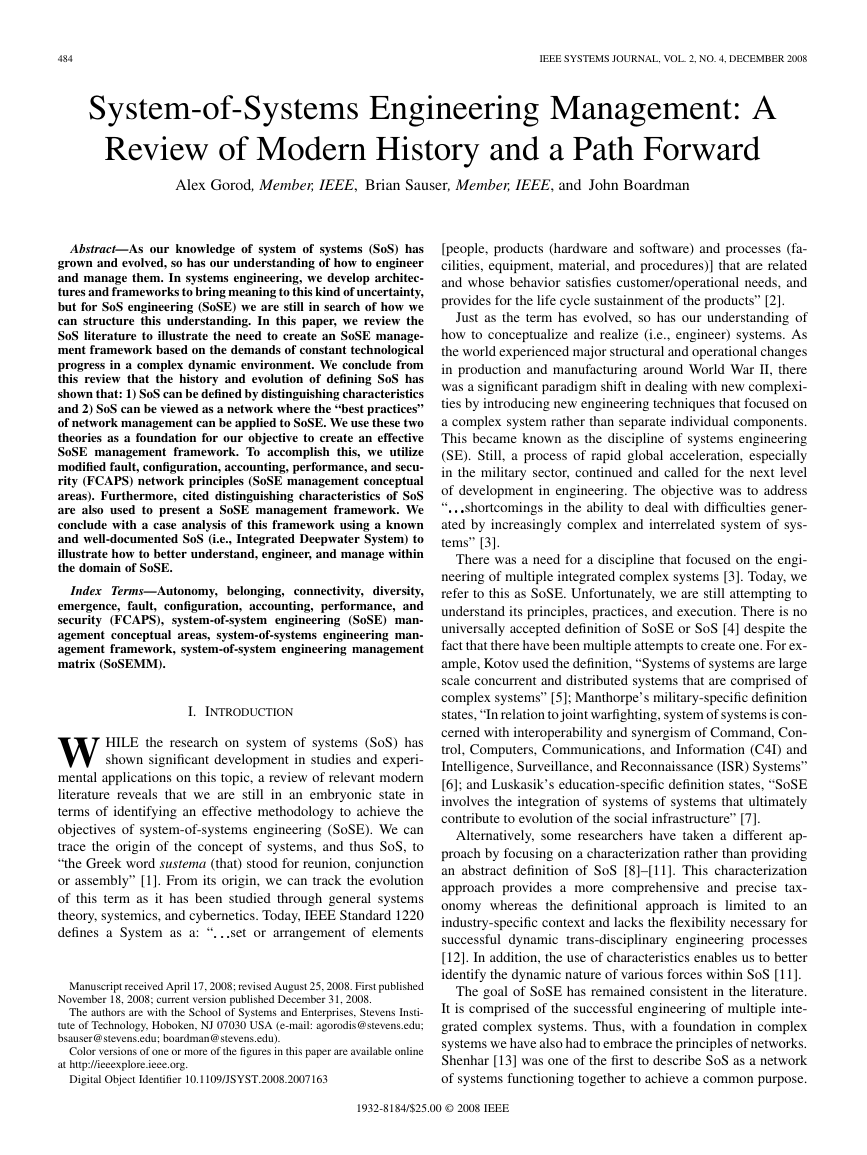

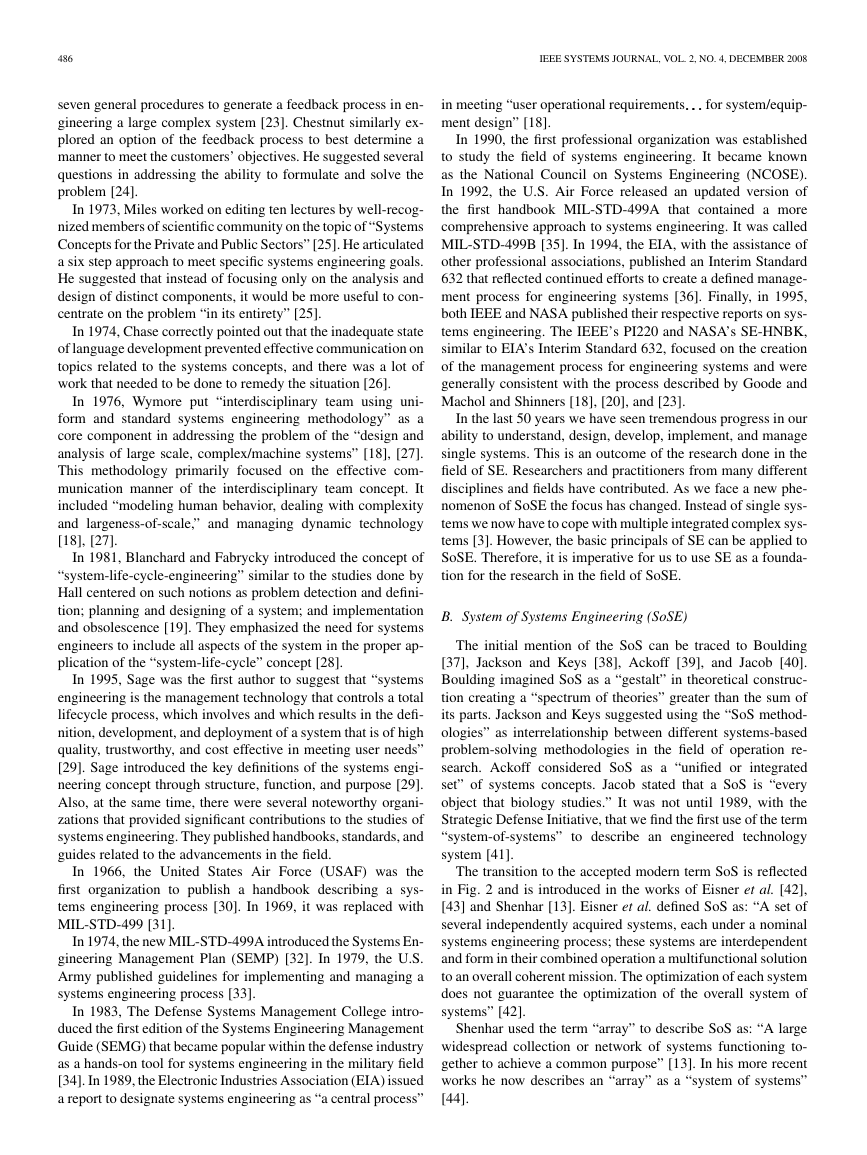
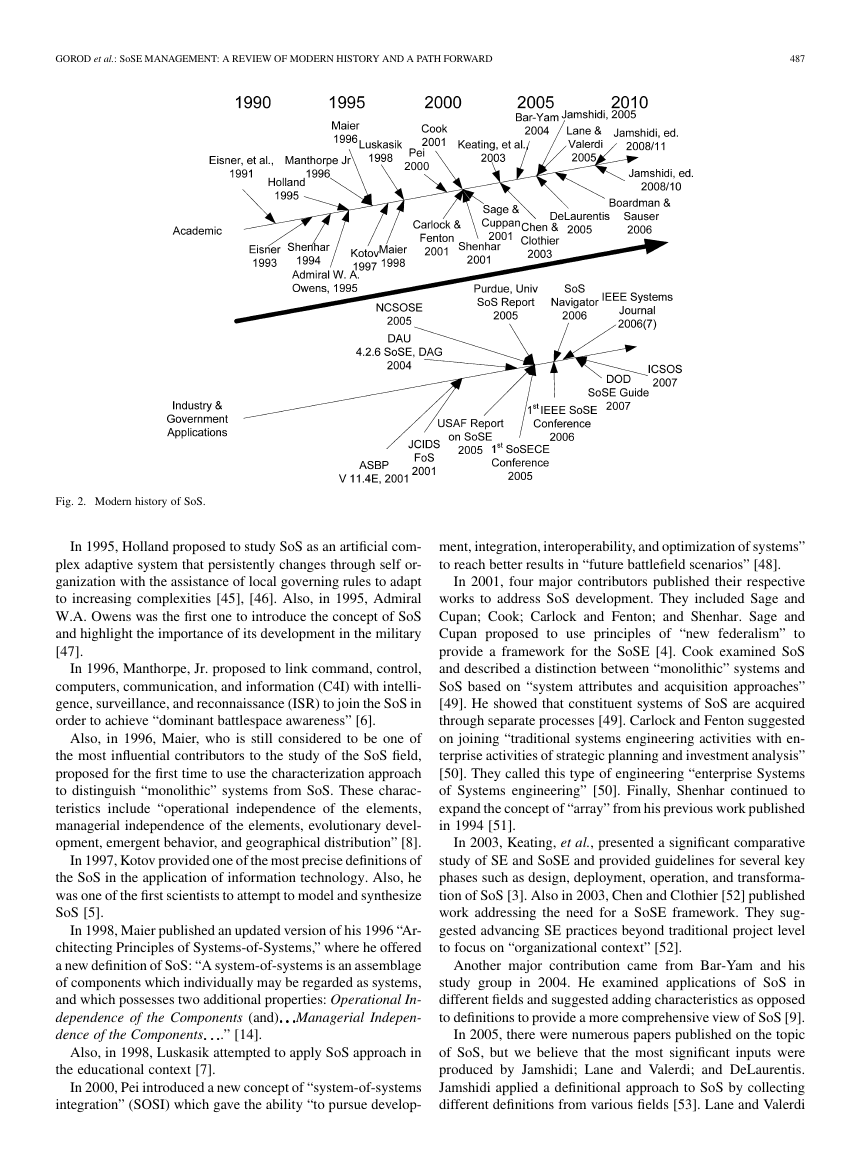
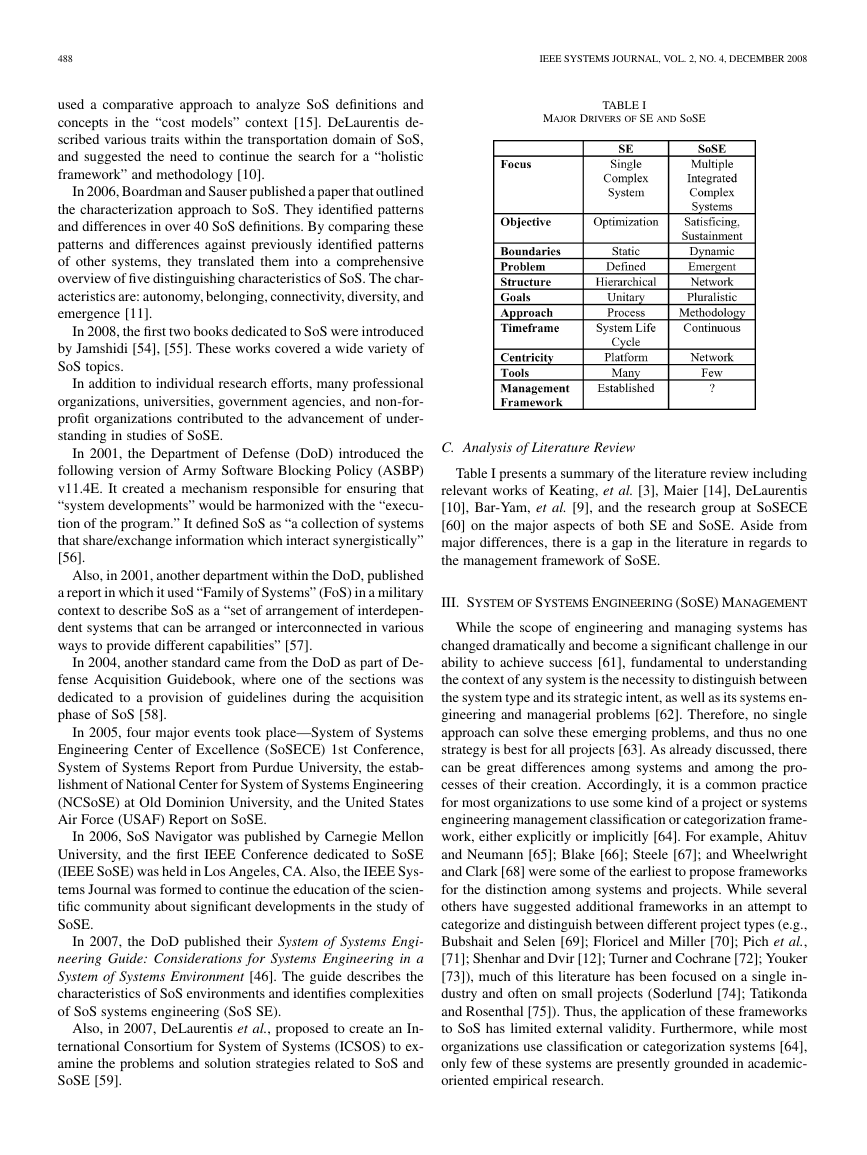
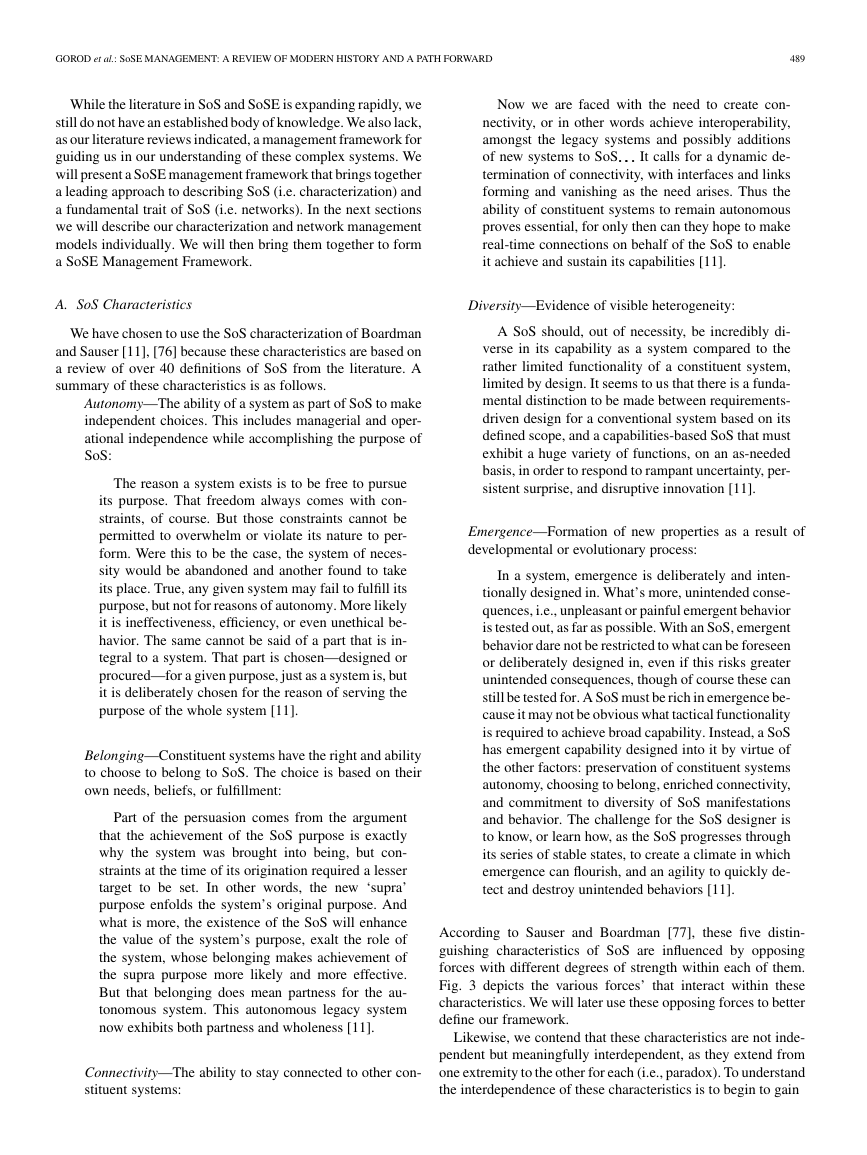
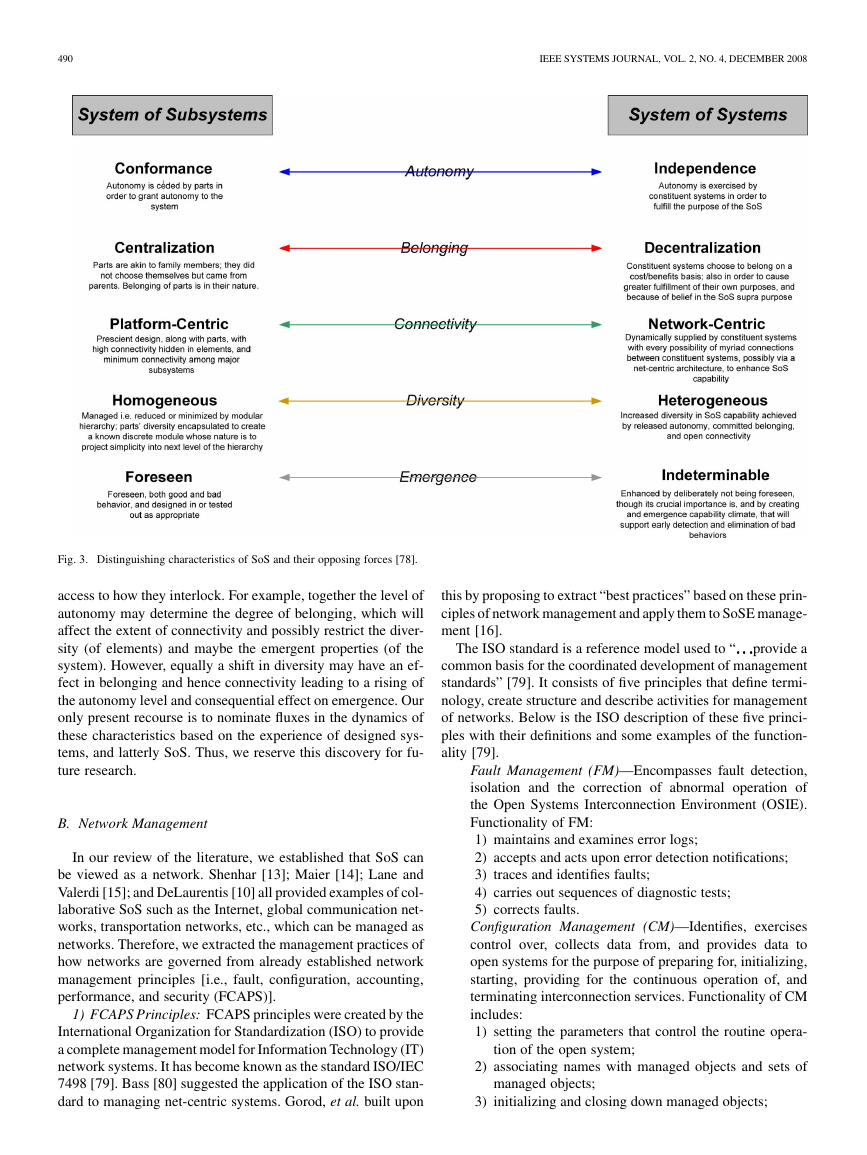









 2023年江西萍乡中考道德与法治真题及答案.doc
2023年江西萍乡中考道德与法治真题及答案.doc 2012年重庆南川中考生物真题及答案.doc
2012年重庆南川中考生物真题及答案.doc 2013年江西师范大学地理学综合及文艺理论基础考研真题.doc
2013年江西师范大学地理学综合及文艺理论基础考研真题.doc 2020年四川甘孜小升初语文真题及答案I卷.doc
2020年四川甘孜小升初语文真题及答案I卷.doc 2020年注册岩土工程师专业基础考试真题及答案.doc
2020年注册岩土工程师专业基础考试真题及答案.doc 2023-2024学年福建省厦门市九年级上学期数学月考试题及答案.doc
2023-2024学年福建省厦门市九年级上学期数学月考试题及答案.doc 2021-2022学年辽宁省沈阳市大东区九年级上学期语文期末试题及答案.doc
2021-2022学年辽宁省沈阳市大东区九年级上学期语文期末试题及答案.doc 2022-2023学年北京东城区初三第一学期物理期末试卷及答案.doc
2022-2023学年北京东城区初三第一学期物理期末试卷及答案.doc 2018上半年江西教师资格初中地理学科知识与教学能力真题及答案.doc
2018上半年江西教师资格初中地理学科知识与教学能力真题及答案.doc 2012年河北国家公务员申论考试真题及答案-省级.doc
2012年河北国家公务员申论考试真题及答案-省级.doc 2020-2021学年江苏省扬州市江都区邵樊片九年级上学期数学第一次质量检测试题及答案.doc
2020-2021学年江苏省扬州市江都区邵樊片九年级上学期数学第一次质量检测试题及答案.doc 2022下半年黑龙江教师资格证中学综合素质真题及答案.doc
2022下半年黑龙江教师资格证中学综合素质真题及答案.doc